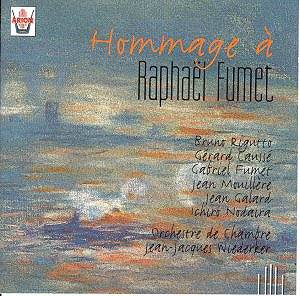Fumet came of a very musical and literary family. After
studies with d'Indy he would have none of the aesthetic guerilla warfare
of the Parisian scene. He withdrew from the Paris (where he had played
organ at various cinemas) at first to Seine-et-Marne and then to Angers.
He had previously enjoyed his years in Montparnasse - a figure associated
with artist friends such as Modigliani, Juan Gris, Joseph Bernard and
Jeanne Hébuterre. He died in Angers.
Pace the fulsome notes L'Anges des Bois
(piano solo, Rigutto) is an ombrageous rhapsody with an improvisatory
feel. The Slavonic-Hebraic Lacrimosa is well taken by
the clean-toned Caussée - a player on the world stage, as is
Rigutto (who you may recall from a recording of the Dvorak Piano Concerto).
The viola sings smoothly in the neatly rounded Barcarolle. La
Rose is in much the same mood though Mouillère does not
have quite the smooth tone production of Caussée.
The Ode Concertante is of another order
of magnitude altogether in terms of inventive imagination. Any French
piece for flute and piano (originally written or flute and string orchestra)
raises Syrinx-like expectations but this Pan-like work takes
a shaded route through the Groves of Dodona. The shadows suggest not
just cool (always welcome) but cold and the threat of the woodland bestiary
of classical Greece. Impressive indeed but the breathy playing dilutes
some of the effect. It would be great to hear what Sharon Bezaly would
make of this or indeed Kenneth Smith. It is too much to hope that this
would be recorded by James Galway?
The furious flight of the harmonically-tanged Toccata
(Galard) comes as a bit of a shock after all this chamber music. Its
grand plan and general free thinking approach reminded me of the Concertante.
It is no mere scion to the famous Widor and Vierne appetisers.
La Nuit for string orchestra is further
evidence of an unruly and liberated mind who felt more in common with
the likes of Schrecker, Zemlinsky, Schoenberg (Gurrelieder, Pelleas
et Melisande), Goossens and Van Dieren than with the prettier fragrances
of Ravel and Debussy. This is music of understatement and subtlety,
It was composed for ORTF to illustrate a poem by Pierre Emmanuel. Expect
more Berg and Siegfried Idyll than Ravel or Debussy.
It is mildly frustrating to be denied dates for these
works. However the notes are otherwise useful if prone to special pleading.
This further affirms the variety of the Gallic treasury. There is a
British Music Society. Why is there not a French Music Society, I wonder?
Let us now keep our fingers crossed for a recording
of Fumet's Symphonie de l'Ame, a string quartet, a wind quintet
and various other orchestral works.
Rob Barnett
